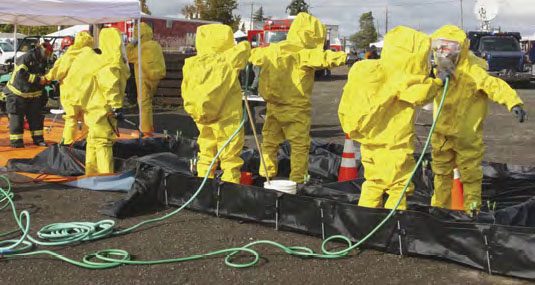Extreme Wastewater Treatment: Deconstructing Chemical Weapons

By Dean Amhaus, first president and CEO, The Water Council and Thomas Ausloos, VP of marketing and product development, Oberlin Filter Company
Can a filter save the world? Maybe not, but this application highlights the role of innovative water treatment technologies in protecting the health and welfare of the planet.
The Milwaukee region’s water industry is a $10.5 billion market and accounts for 4 percent of the world’s total water technology business. The Water Council, with a growing membership of more than 160 organizations, is situated here, and its members are working to address a broad range of water-related issues to tackle the goal of improving world water health — including the safe destruction of chemical weapons.
Oberlin Filter Company, a Water Council member since 2010, is a manufacturer of automatic pressure filters for solid-liquid separation located in Waukesha, WI. The company was selected to provide filtration equipment for the unique and challenging task of deconstructing U.S. chemical weapons reserves pursuant to the START I and New START treaties.
START I And New START: Strategic Arms Reduction Treaty
Negotiations for the Strategic Arms Reduction Treaty (START) ignited when President Ronald Reagan first proposed the agreement to Mikhail Gorbachev during the Geneva Summit in 1985. The final treaty was not signed and ratified until 1994 during President George W. Bush’s term, mainly due to the complications and turmoil around the dissolution of the Soviet Union. The treaty outlined that Russia and the U.S. would be limited to 6,000 nuclear warheads and 1,600 nuclear delivery vehicles each. This meant both governments must destroy their stockpile of chemical nerve agent weapons, thus leading to a drastic reduction in their combined stockpiles of nuclear warheads.
In 2010, President Barack Obama’s Administration signed and ratified the New START treaty, which further reduced the imposed limits. As outlined in the new treaty, both parties must meet the central limits on strategic arms by Feb. 8, 2018, exactly seven years from the date the treaty was officially executed. The new limits set deployed warheads at 1,550, significantly less than the original START I treaty, and further reduced nuclear delivery vehicles.
Dismantling Chemical Nerve Agents, One Step At A Time
The burning question now is, “How does a nation with such vast chemical weapon reserves safely and securely destroy and dispose of such dangerous arms?” The various secure locations of weapon stockpiles around the country must adopt and undergo a destruction plan of action that may employ a unique technology process, or one similar to plans conducted at other sites.
General Atomics, a specialized contractor for the government, located in San Diego, was tasked with deconstructing reserves located at the Blue Grass Army Depot, outside of Richmond, KY. They were in search of a prefilter that would provide a nearly suspended-solids-free water solution before feeding into their posttreatment process. After General Atomics developed a proprietary process named SCWO (super critical water oxidation), designed to perform the final destruction of the organic components, they selected Oberlin as the solution to their prefilter need to provide a less-than-one-micron, suspended-solids-free solution before feeding their SCWO treatment reactor for the final treatment step. One of the big challenges was the large swing in total suspended solids (TSS) concentrations. The filter needed to be:
- mechanically reliable with high, online operating time
- automatic, to minimize operator exposure
- flexible, in case the feed conditions changed and media had to be modified.
Oberlin came to General Atomics’ attention through a recommendation from one of their consultants and through previous testing/report recommendations done for a similar technology. General Atomics and Oberlin began working together initially with a five-year development process agreement, which eventually led to the two entities forming a partnership to dispose of the weapon reserves at Blue Grass Army Depot, where Oberlin’s automatic pressure filter is still currently installed.
Underneath the levels of personnel and environmental safety protections, the process of destruction is relatively simple and takes only a few steps:
Destruction: The nerve agent is drained from the missile and neutralized in caustic. The energetic (fuel) is also drained and neutralized in caustic. This process is known as hydrolysis, and the resulting chemical compounds are known as hydrolysates. Another parallel step is that the aluminum missile body needs to be thinly sliced and dissolved in caustic. The three hydrolysates are then held to ensure agent destruction before being transferred to the next treatment step.
Neutralization: The next step is the neutralization of the hydrolysates. This involves using a special mixture of HCl, H2SO4, and H3PO4 acids. The neutralization step is very exothermic and results in a solution that contains a high level of aluminum hydroxide, precipitated salts, and unquantified substances. A good portion of this chemistry was developed and filter-tested at Oberlin’s headquarters.
Filtration: This step is accomplished by the automatic pressure filter, which was chosen for its simplicity in mechanical function, its need for minimal operator intervention/safety due to its automatic dry-solids discharge operation, and its ability to provide flexible media selections. The clean filtrate is expected to have TSS around 8 to 20 mg/L (0.45 micron membrane) and an NTU (nephelometric turbidity unit) of 3 to 20. The filtrate was visually clear. The media selected was a 1-micron absolute DuPont Soloflo. The solids filter cake is 25-mm thick with a moisture content of 45 to 50 percent.
Organic Destruction: The final step utilizes the SCWO process, taking the filtrate from the automatic pressure filter and breaking it down into the basic components of CO2, water, and salts. This is accomplished by operating above the supercritical point of water at >3200 psi and >700°F where water exhibits unique properties and where organic compounds are quickly converted to carbon dioxide and water in the presence of oxygen.

Milwaukee’s Water Cluster: A Global Health Steward
The role that Oberlin Filter plays in the deconstruction and disarmament of chemical nerve agent weapons is crucial in providing a safe, reliable, and precise filtration step during the destruction process. It also exemplifies the work that Water Council members are doing to create a safer environment for all, addressing a broad range of global water challenges through the development and deployment of innovative technologies — such as filters that disarm chemical weapons.
About The Authors

Dean Amhaus has served as the first president and CEO of The Water Council since March 2010. The Council seeks to grow the Milwaukee region into a world hub for water research, education, and economic development. Amhaus holds an MBA from the University of Wisconsin-Whitewater and a B.S. in business from the University of Wisconsin-Platteville.

Thomas Ausloos has spent the last 28 years at Oberlin Filter Company, where he is currently VP of marketing and product development. He holds a B.S. in chemical engineering from the University of Wisconsin-Madison.
